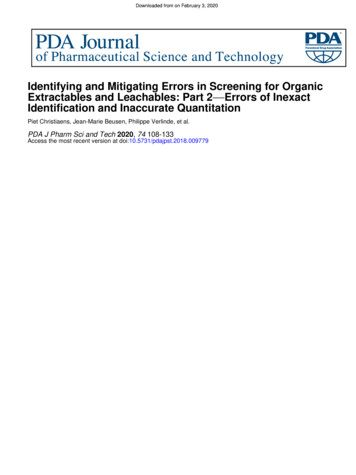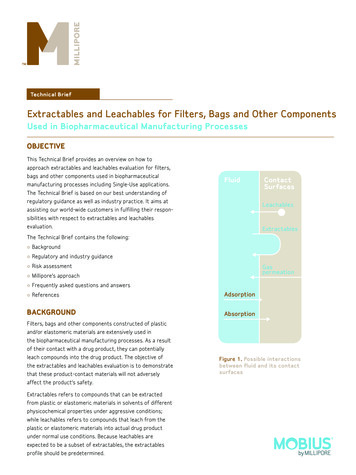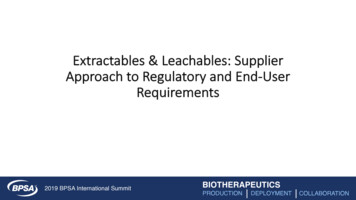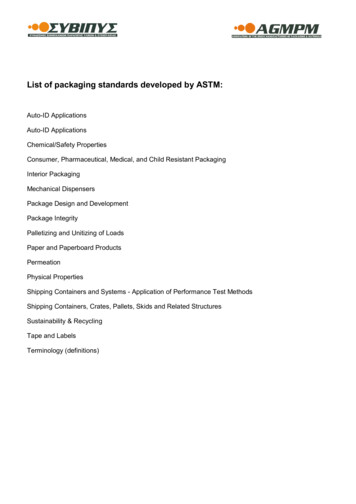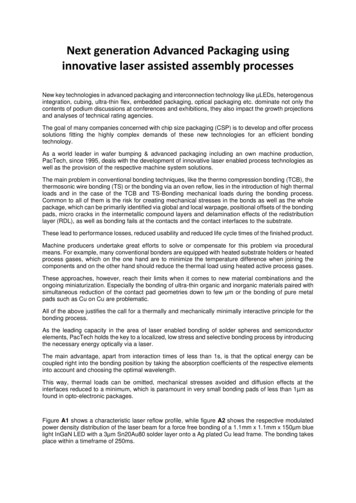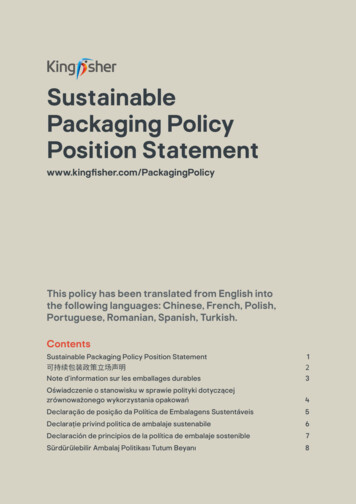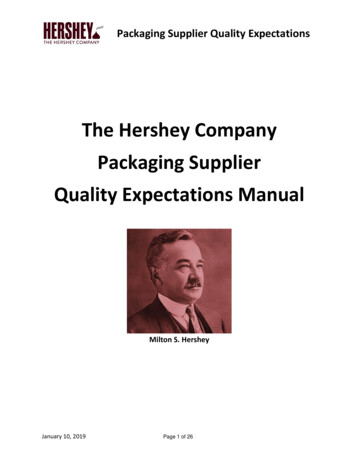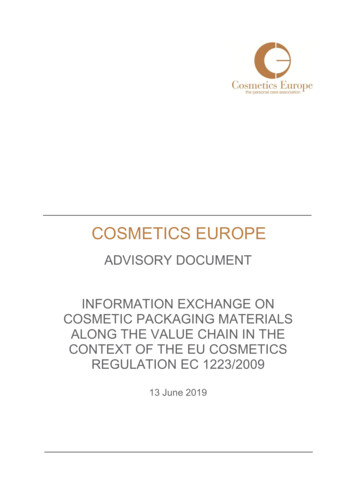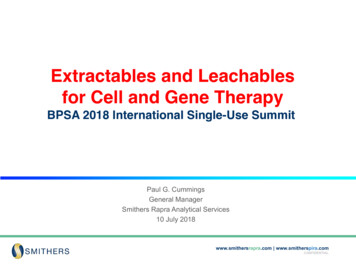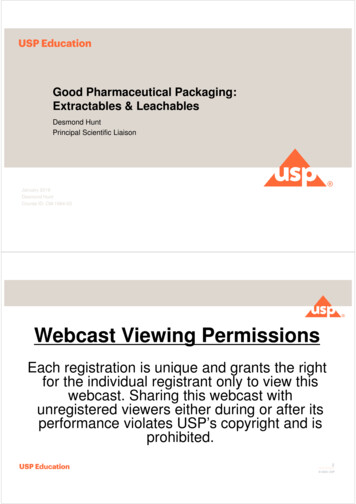
Transcription
Good Pharmaceutical Packaging:Extractables & LeachablesDesmond HuntPrincipal Scientific LiaisonJanuary 2019Desmond HuntCourse ID: CM-1664-03Webcast Viewing PermissionsEach registration is unique and grants the rightfor the individual registrant only to view thiswebcast. Sharing this webcast withunregistered viewers either during or after itsperformance violates USP’s copyright and isprohibited.2 2020 USP
DisclaimerBecause USP text and publications may have legal implications in the U.S. and elsewhere, their language muststand on its own. USP shall not provide an official ex post facto interpretation to one party, thereby placing otherparties without that interpretation at a possible disadvantage. The requirements shall be uniformly and equallyavailable to all parties.In addition, USP shall not provide an official opinion on whether a particular article does or does not comply withcompendial requirements, except as part of an established USP verification or other conformity assessmentprogram that is conducted separately from and independent of USPs standards-setting activities.Certain commercial equipment, instruments or materials may be identified in this presentation to specifyadequately the experimental procedure. Such identification does not imply approval, endorsement orcertification by USP of a particular brand or product, nor does it imply that the equipment, instrument or materialis necessarily the best available for the purpose or that any other brand or product was judged to beunsatisfactory or inadequate.This course material is USP Property. Duplication or distribution without USP’s written permission is prohibited.USP has tried to ensure the proper use and attribution of outside material included in these slides. If,inadvertently, an error or omission has occurred, please bring it to our attention. We will in good faith correctany error or omission that is brought to our attention. You may email us at: legal@usp.org.3 2020 USPDesmond HuntUSP Affiliation: USP employee since 2005Title:Principal Scientific LiaisonEducation:Ph.D., University of Texas, Austin, USADr. Desmond G. Hunt has been with USP since 2005 and holds the position of PrincipleScientific Liaison in the Compendial Science Group-General Chapters. He is thescientific liaison to the Packaging and Distribution and Dosage Forms ExpertCommittees, where he works to develop and revise USP Standards. He has authoredmany publications and peer-reviewed articles and is a frequent speaker and instructoron topics related to pharmaceutical packaging, particulate matter in parenteral andophthalmic dosage forms and good storage and transportation practices. Heparticipates on several industry Working Groups and Technical Committees related tohis areas of expertise. Dr. Hunt obtained his M.S. and Ph.D. from the University ofTexas at Austin and prior to joining USP, was a Research Fellow at the NationalInstitutes of Health, Bethesda, MD, USA.4 2020 USP
Course AgendaModule 1.Quality ConceptsModule 2.Importance of Material QualityModule 3.Extractables and Leachables Evaluation: General ConsiderationsModule 4.Material Selection and Early AssessmentModule 5.Principles of Extractable AssessmentModule 6.Evaluation of ExtractablesModule 7.Principles of Leachable Assessment – USP 1664 5 2020 USPMODULE 1: Quality Concepts
Quality – Drug PackagingSystem (E&L)DrugProductQuality7 2020 USPQuality – Packaging Systems21CFR § 211.94 Drug Product Containers & Closures1.Drug product containers and closures shall not be reactive, additive, orabsorptive so as to alter the safety, identity, strength, quality, or purity of thedrug beyond the official or established requirements.2.Container closure systems shall provide adequate protection againstforeseeable external factors in storage and use that can cause deterioration orcontamination of the drug product.3.Drug product containers and closures shall be clean and, where indicated bythe nature of the drug, sterilized and processed. to assure that they aresuitable for their intended use.8 2020 USP
Quality Attributes for Packaging Systems/Devices Suitability Performance– for intended use includes: FunctionalityCompatibility Safety–Chemical composition (Extractables)–Chemical migration (Leachables)Protection–Loss of –pH change–Microbes–Brittleness of PackageSource: 1999 FDA Guidance for Industry: Container Closure Systems for Packaging Human Drugs and Biologics9 2020 USPExtractables and Leachables Extractables are organic and inorganic chemical entities that are released froma pharmaceutical packaging system/delivery system, packaging component, orpackaging material of construction and into an extraction solvent underlaboratory conditions. Leachables are foreign organic and inorganic chemical entities that are presentin a packaged drug product because they have leached into the packaged drugproduct from a packaging/ delivery system, packaging component, or packagingmaterial of construction under normal conditions of storage and use or duringaccelerated drug product stability studies. They are not related to either thedrug product itself or its vehicle and ingredients.–Leachables are typically derived from primary and secondary packaging, as the primary andsecondary packaging can serve as a barrier between the packaged drug product and otherpotential sources of chemical entities (such as tertiary packaging and ancillary components)10 2020 USP
Material Quality Impacts Product Quality Concerns for Leachables–Patient Safety–Interference with Biological Manufacturing Process–Interference with Drug Product Assays–Interference with Biological Assays–Interference with Medical Diagnostic Tests–Contribute to Leachables Level of Drug Product Producing an Unacceptable Level–Reaction with Active Pharmaceutical Ingredients (APIs) and/or Excipients to affect thestructure, function and stability of the APIs11 2020 USPMODULE 2: Importance of MaterialQuality
Potential Material – Product Interactions Primary Packaging Materials:– Primary Packaging Components:–Bottles, Cartridges, Plastic Bags, Pre-filled Syringes, Vials–Dry Powder Inhalers, Metered Dose Inhalers, Nasal Sprays–Tubes–Blister Packs, BottlesSecondary Packaging Materials:– Glass, Plastic, Elastomers, Aluminum Foil, AdhesivesPaper (Labels), Ink, Cardboard, AdhesivesAssociated Components:–Wood Pallets, Shipping Components, etc.13 2020 USPPotential Material – Product Interactions In order to understand what are the potential Extractables from materials ofconstruction, we need to obtain as much as possible knowledge:–Ingredients and their quality–Ingredient supply chain–Method of manufacture and sterilization–What Goes in — May Come Out!Materials of Construction–Glass, Plastic, Elastomers, Metals–Associated Components14 2020 USP
Supply Chain – Glass Raw Materials for Glass ManufactureMatrixSandSiO2Fluxing AgentsSoda Ash (Na2CO3)Potash(K2CO3)Na2OK2OStabilizersLimestone (CaCO3)Aluminum OxideBoron TrioxideCaOAl2O3B2O315 2020 USPSupply Chain – Glass Role of Additives to Sand (SiO2)MaterialRoleAl2O3Chemical ResistanceB2O3Strength & Chemical ResistanceCaOChemical Resistance & HardnessNa2OLowers Melting PointK2 OLowers Melting Point16 2020 USP
Glass CompositionTypical Composition of Glass Soda-Lime-Silica GlassBorosilicate Glass71% – 75% SiO272% – 82% SiO212% – 16% Na2O/K2O4% – 10% Na2O/ K2O10% – 15% CaO/MgO9% – 13% B2O31% – 3% Al2O32% – 7% Al2O317 2020 USPManufacture of Glass ContainersSupply Chain – Glass Molded Glass:–Form Vials & Bottles–Anneal in LehrMolded Glass is Heated 2xTubing Glass:–Form Tubing Canes–Convert Canes into Ampoules,Bottles, Cartridges, Pre-fillableSyringes or Vials–Anneal in LehrPhoto Source: Schott with permissionTubing Glass is Heated 3x18 2020 USP
Supply Chain – GlassEffect of Heating on Glass Heating glass will cause material evaporation Higher temperatures & longer working times greater material evaporation Borosilicate glass: evaporates are mainly alkali borates which condense oncolder parts of container Aqueous solutions of alkali borates give pH shift to high values Excessive heat gives a more vulnerable surface leading to surface flaking19 2020 USPSupply Chain – GlassRegulating Surface Hydrolytic Activity Why does surface hydrolytic activity matter? Degree of surface activity varies with: –Glass Type: Borosilicate or Soda-Lime-Silica–Surface treatment of glass–Manufacturing Process: Molded vs. TubularDegree of surface activity will effect:–Interaction with drugs–Surface stability and extractables20 2020 USP
Glass ExtractablesInorganic Components Major Extractables: Na, Si Minor Extractables: Al, B, Ca, K Trace Extractables: Fe, Mg, Zn–Can extractables from glass produce problems in formulations?–What happens to glass when it loses structural elements?21 2020 USPCase Study – Glass Vial FDA Case Study:–Change: Switch from molded to tubular vials–Problem: Aluminum leached from tubular vials and interacted with sodium phosphate buffer inthe formulation to form aluminum phosphate crystals–Impact: Visible particles were formed at 12 months storage–Resolution: Lots containing particles were recalled and new lots of vials were coated withbaked-on siliconeIngrid Markovic. USP E&L Workshop 201322 2020 USP
Case Study – Glass Vial FDA Case Study:–Change: Switch of glass vial vendors–Problem: Barium leached from the new vials and interacted with sodium sulfate in theformulation to form barium sulfate crystals–Impact: Visible particles were formed at 18 months storage–Resolution: Acceptable level for barium was established with a commitment to generatestability data for 10 new lotsIngrid Markovic. USP E&L Workshop 201323 2020 USPSupply Chain – PlasticsManufacturing Components Connectors, Filters, Reactors, Stirrers, Tanks, TubingPrimary Plastic Packaging Bags, PFS, Vials Parenteral Drugs Blow - Fill - Seal Ophthalmic Drops Blow - Fill - Seal Nasal Sprays Bottles Oral Liquids, Tablets DPI/MDI Inhalers Film Tablets (blister packs)24 2020 USP
Formulation: Ingredients and Roles Polymer formulations include additives to enhance its performance––Stabilizers – Maintain the polymers original properties Strength Flexibility ToughnessModifiers – Change or improve polymer performance Performance additives – e.g., slip agents, anti-static agents Fillers and Pigments25 2020 USPSupply Chain – turingMasterBatcherMoldingShop ConverterBulk Chemicals,Storage essing Aids,OthersStabilizers,Antioxidants,Processing Aids,Antistatic Agents,Others(N)End ,ColorantsTrade Secret ProtectedA. Shaw. RAPRA Extractables & Leachables Conference. September 201026 2020 USP
Finished Component (N-1) – Supply Chain Knowledge of Suppliers–How do supplier facilities operate?–What is the GMP status of suppliers?–What is the relationship between various suppliers(N-1, N-2, etc.)?–What are the appropriate change controlprocedures?27 2020 USPFinished Component (N-1) – Supply Chain Supplier Risk Mitigation Activities–Long term supply (or quality) agreement–Supplier audit–Supplier quality assessment–Purchasing specification Includes change control agreement–Risk questionnaire–Develop a frequency for on-site audit based upon supplier quality history, performance, etc.–Testing of raw materials prior to use in manufacturing28 2020 USP
Supply Chain – Elastomers Elastomers for Parenteral Products–Components for Container-Closure Systems – e.g., stoppers for vials, bottles, plastic bag ports–Components for Injection Systems – e.g., plungers, tip caps, needle shields–Components for Medical Devices – e.g., parts for Metered Dose Inhalers29 2020 USPSupply Chain – Elastomers Formulations: Ingredients and RolesIngredientRoleElastomerBase material: bromobutyl, chlorobutyl, halobutylFillerInfluences physical properties: clay, talc, carbonatesPlasticizerProcessing aidCuring AgentForms cross-links: Sulfur, S-donors, phenol-formaldehydeAcceleratorCross-link type and rate: carbamates, sulfenamidesActivatorGive onset of vulcanization: ZnO stearic acidAnti-oxidantStabilizer: BHT, Irganox 1010PigmentColor30 2020 USP
Supply Chain – Elastomers Thermoset Rubber Formulation: ThenIngredientChlorobutyl Rubber% by Weight52.7%AdditivesCalcined Clay39.5%Paraffinic Oil4.2%Zinc Oxide1.6%Thiuram0.1%Hindered Phenol Anti-Oxidant0.5%Titanium Oxide/Carbon Black1.3%31 2020 USPSupply Chain – ElastomersThermoset Rubber Formulation: NowIngredient% by WeightAdditivesMineral Fillers34.4%Butylated hydroxytoluene0.3%Antioxidant0.3%Peroxide1.0%32 2020 USP
Supply Chain – Elastomers Elastomers for pharmaceuticals have become much cleaner over the lastdecades:–Lower number of ingredients–Cleaner ingredients–Coating of stoppers/plungers Composition of Elastomers is still very complex Extractables from:–Formulation ingredients–Impurities in ingredients (solvents, halides, oligomers)–Reaction/degradation products during elastomer manufacturing33 2020 USPSupply Chain – Elastomers Modern Rubber Formulations–Alternative fillers (lower levels of PAHs ornone)–Peroxide cured (no nitrosamines)–Levels of curing agents and additivesoptimized (lower levels of extractables) Older Rubber Formulations–Carbon Black Fillers (PAHs)–Sulfur Cured (Nitrosamines)–Excess levels of curing agents andadditives34 2020 USP
Supply Chain – ElastomersExtractable profile of a modernMDI elastomeric valvecomponentExtractable profile of an oldMDI elastomeric valvecomponent35 2020 USPCoated Elastomers for Vials & Pre-filled SyringesUncoated Topof PlugPiston Partially CoatedUncoatedSide and TopPiston Fully Coated36 2020 USP
Extractables: Coated Versus Non-Coated ElastomersExtraction of Organic Components into n-Heptane (GC)Uncoated PlungerCoated Plunger37 2020 USPCase Study: Elastomers Problem: Particles (10 to 200 µm) observed in diluent vials containing aphosphate buffer at 6 months Source: Particles identified as zinc phosphate. Zinc oxide is present in thebromobutyl stopper. Leached [zinc ion] required to form precipitate was only 224ppb Resolution: Switch to a chlorobutyl stopper that does not contain zincCastner J. et al. American Pharmaceutical Review Pages 70 – 75, March –April 200438 2020 USP
Case Study: Elastomers FDA Case Study:–Problem: Butylated hydroxytoluene (BHT) was observed in a lyophilized product at 12 monthsafter switching from latex to a chlorobutyl stopper–Source: BHT, a common food additive, was found at very low levels and has very low toxicity.Its source was the butyl rubber stopper–Resolution: Set acceptance level for BHT and continue to monitor BHT levelsIngrid Markovic, FDA CDER American Pharmaceutical Review Pages 96 – 101, May-June 200939 2020 USPCase Study: Elastomers FDA Case Study:–Problem: Iron leachables catalyzed oxidation of the preservative and other excipientstriggering formation of protein-preservative adducts. Decrease in potency.–Source: months. Uncoated stoppers released iron at levels 1 ppm and the shelf life datinghad been extended from 15 to 18 months–Resolution: Recall affected lots, return to 15 month shelf life, and implement coated stoppers.Eventual removal of product from marketIngrid Markovic, FDA PQRI Workshop on Thresholds and Best Practices for Parenteral and Ophthalmic Drug Products 201140 2020 USP
MODULE 3: Extractables andLeachables Evaluation:General ConsiderationsExtractables and Leachables – Introduction Key Questions:–Why?–When?–How?42 2020 USP
Extractables and Leachables – Why?The expectation by regulatory authorities, globally, is that E&Lstudies be preformed for high risk dosage forms43 2020 USPExtractables and Leachables – When? When should extractable testing start? When should extractable testing be completed? When should leachable testing start?–Packaging for Drug Products:44 2020 USP
Evaluation of Packaging E&L (NDA) – When?PhaseIIIComponents: ExtractablesSurvey of information(consider all components)System (drug mfg. process package):LeachablesWhat is the level of concern?Analytical characterizationControl alcompoundsToxopinionControlcomponentsMonitor leachablesOptimize methodsIIIE L: Validated methodsStability testing45 2020 USPEvaluation of Packaging E&L (ANDA) – When?ProjectStartComponents: ExtractablesSystem (drug mfg. process package):LeachablesSurvey of information(consider all components)What is the level of concern?Analytical characterizationControl alcompoundsToxopinionControlcomponentsMonitor leachablesOptimize methodsE L: Validated methodsStability testing46 2020 USP
Evaluation of Packaging E&L – When? Packaging Platform Approach–Conduct Extractable studies on a specific container-closure system (CCS), e.g., glassvial/stopper, plastic pre-filled syringe/plunger combination, plastic bags Use a specific CCS for a number of products with similar extracting power Advantage is that extractable data is available and methods are devised and validated Stability studies can start immediately looking for leachables47 2020 USPExtractables & Leachables – How ? Guidance in USP General Information Chapter 1663 Assessment ofExtractables Associated with Pharmaceutical Packaging/Delivery Systems –Module 8 Evaluation of Extractables – Module 9 Guidance in USP General Information Chapter 1664 Assessment of DrugProduct Leachables Associated with Pharmaceutical Packaging/DeliverySystems – Module 1048 2020 USP
MODULE 4: MaterialsSelection and EarlyAssessmentMaterials Selection and Early Assessment Understanding:–Nature of the manufacturing components–Nature of the packaging system–Packaging component supply-chain(s) –Packaging system material composition –Supplier InformationSupplier InformationDrug product risk level50 2020 USP
Dosage Form “Risk”: USP 1664 Table 1. Modified FDA/CDER/CBER Risk-Based Approach toConsideration of LeachablesExamples of Packaging Concerns for Common Classes of Drug ProductsDegree of ConcernAssociated with theRoute of AdministrationLikelihood of Packaging Component-Dosage Form InteractionHighMediumLowHighestInhalation Aerosols andSpraysInjections and InjectableSuspensions; InhalationSolutionsSterile Powders and PowdersforInjection; Inhalation PowdersHighTransdermal Ointments andPatchesOphthalmic Solutions andSuspensions; NasalAerosols and SpraysLowTopical Solutions andSuspensions; Topical andLingual Aerosols; OralSolutions and Suspensions——Oral Tablets and Oral (Hardand Soft Gelatin) Capsules;Topical Powders; OralPowders51 2020 USPMaterials Selection and Early Assessment High-Risk Dosage Forms–Safety assessment recommended during container closure system component selection–Controlled Extraction Studies required for all “critical components”–Drug product leachables studies required–Extractables/leachables correlation required–Extractables and leachables specifications and acceptance criteria required52 2020 USP
Materials Selection and Early Assessment Low-Risk Dosage Forms–Low Risk does not No Risk–Chemical Composition of all plastics, elastomers and adhesives–Appropriate references to indirect food additive regulations–For glass and plastic containers, data from USP containers is required (testing should be onthe packaging component not the unformed resin)–Method(s) to monitor consistency of composition, as appropriate53 2020 USPMaterials Selection and Early Assessment Desirable Information to Obtain from Suppliers–The base elastomeric/polymeric material (e.g., high density polyethylene, butyl rubber, stainless steel)–The additive composition of the component Reaction/degradation chemistry–Polymerization process plus associated polymerization/curing agents–Fabrication process, including additives designed to assist in fabrication–Cleaning/washing processes for finished components–Storage/shipping environment for components–Technical Data Sheets–Confidential Information on Qualitative Composition–Since Plastic & Rubber formulations are proprietary, it is difficult to obtain information on the formulation–Vendors may supply list of “potential” Extractables observed with common solvents e.g., water–Results may confirm vendors list and/or find new Extractables54 2020 USP
Materials Selection and Early AssessmentConsiderations in Component Selection For all dosage forms:–Components containing sources of known potent carcinogens or mutagens should beavoided/minimized, e.g.: Polynuclear Aromatic Hydrocarbons (PNAs) N-nitrosamines 2-Mercaptobenzothiozole (2-MBT)55 2020 USPMaterials Selection and Early Assessment What Role Does the Toxicologist Play?Resource can be in-house or outsourcedProduct PhaseDesign PhaseDevelopment PhasePost-Market MaterialChangesObjectiveDesign out undesirablesubstances; design in safe andfunctional materialsPerform ISO, Toxicology,E&L studies to fullyevaluate material safetyPerform difference studiesand appropriate ISO,Toxicology, E&L studies asneededToxicologist RoleQualitative or semi-qualitativestatement of general safety risksQuantitative andcomprehensive safetyrisk assessmentQuantitative safety riskassessment focusing on thechanges56 2020 USP
Safety Assessment of LeachablesThere are currently no regulatory guidelines in place for how to assess therisk of leachables and extractables Generally:–Comprehensive assessments are performed for each chemical compound (above sciencebased thresholds)–Assessments are based upon Available animal and human toxicology data (i.e., literature) Chemical structure – activity analysis (i.e., databases)57 2020 USPRisk Assessment of Leachables – What is NeededToxicologists Need to know Identity of extractable Dose – under conditions of maximum daily use of the drug, how much of a totaldaily dose in ppm of the leachable will be administered to humans? –If Drug A is given at 1 gram/day, the dose of a leachable present @ 1 ppm is 1 μg–If Drug B is given at 10 mg/day, the dose of a leachable present @ 100 ppm is also 1 μgDuration – How long will the patient be exposed to the leachable?–Chronic, daily exposure to a potential toxin always carries a higher theoretical risk of eliciting anadverse effect than short-term exposure–Greater scrutiny of safety data supporting a leachable will be paid to those in chronic use drugsRoute of Administration – Can affect the toxicological profile of any toxin–If not absorbed, may not be toxic via the oral route, but very toxic intravenously!–Different metabolites can form from exposure to the body via different routes (i.e., oral versusintravenous)58 2020 USP
Risk Assessment of Leachables – What is Needed Patient population – Are patients with a disease receiving the drug containingleachable(s); health status can influence the risk assessment Indication –What is being treated by the drug has great influence on a riskassessment; greater risk is tolerated if the drug is to treat a life-threatening illness! “Special” populations – factors such as a potential pediatric indication,administration to an elderly population, need to be understood to better assesspotential risk59 2020 USPRisk Assessment of Extractables Irgafos 168 Phosphate (Di-tertiary butyl phenyl phosphate)–Irgafos 168 phosphate extractable wasobserved–This is an oxidized reaction product ofIrgafos 168 phosphite (contains additionaloxygen atom)–Could likely present as a leachable;observed in a solvent extraction conditiondeemed “highly relevant” to the clinical formulation–Highest IV “extractable dose” is 50 µg/day (1.0 µg/kg/day)–Data on compound is not available!OOPOO60 2020 USP
Risk Assessment of Extractables Neither structure (Irgafos 168 phosphite or phosphate) gave concern formutagenicity, carcinogenicity, or systemic toxicity in humans– Irgafos 168 phosphite has sufficient safety data available to enable a riskassessment of Irgafos 168 phosphate– Identical results obtained for both compoundsEven assuming the unlikely scenario that the extractable dose is the same as the leachabledose (“worst case” situation)Proceed with confidence with migration studies knowing that if Irgafos 168phosphate presents as a leachable, its risk can be assessed61 2020 USPRisk Assessment of propanol – like nucleus (CAS #55956-25-7)H 2C–I only have a partial structure–“Several” unidentified extractables were likely to sharethis nucleusOCH3––They might present as leachables; observed in morethan 1 solvent extraction conditions collectivelydeeming them “possibly relevant” to the clinicalformulationOHOCH3No safety data available for the base structure62 2020 USP
Risk Assessment of Extractables DEREK structural analysis yielded no alerts for mutagenicity, carcinogenicity, orsystemic toxicity matters of concern to humans Nevertheless, the additional chemical constituents in the unidentified chemicalscontaining this nucleus may posses concerning toxicophores–Potentially problematic if not characterized prior to conducting migration study Recommended further clarification of structures sharing this nucleus beforeproceeding with migration work Once structures are characterized, do a toxicological re-evaluation to determineif safety could be supported if these were to go on to become leachables63 2020 USPMODULE 5: USP Chapter 1663 – Principles ofExtractable Assessment
Extractable Assessment Best PracticesStudiesKey CharacteristicsMaterial Characterization(Tentative Leachables) Screening of packaging candidates Establish composition of extractable materials Broad Based/Screening extraction and testing(Semi-quantitative) Toxicological AlertsSimulation Study(Probable Leachables) Leachables Study(Confirmed Leachables) Establish the actual accumulation of target leachables Drug product under actual conditions of use Toxicological assessment of all targeted leachablesOutcome: Negligible or unacceptable safety riskEstablish worst case accumulation of leachablesConditions to mimic worst case (accelerated)Justified simulating solventsAssessment of all extractables above the AETIdentify Leachable TargetsSource: Thresholds and Best Practices for Parenteral and Ophthalmic Drug Products (PODP) Workshop Houston/ Egert/Hendricker February 22-23, 201165 2020 USPPurpose of an Extraction Study Material characterization of the packaging components Compare supplier information with empirical data – Confirmation “Impurities profiling” of the materials–Identify as many potential “Bad Actors” as possible Early risk evaluation Identify compounds that may need to be monitored as leachable –Concentration in the materials–Risk for migration–ToxicityNOT a Final Step in a Safety Assessment!66 2020 USP
Parameters to be Considered in an Extraction Study Extraction Study: what are the scientific principles and best demonstratedpractices under which it should be accomplished? Extraction Study: consists of two critical dimensions:–Laboratory generation of the extract (Extraction)–Testing the extract (Characterization)67 2020 USPParameters to be Considered in an Extraction Study An extraction process is accomplished by steps that are based on themanipulation of several experimental parameters, including:–The chemical nature of the extracting media–The time duration of the extraction process–The temperature at which the extraction is performed–The stoichiometry of the extraction process (extracted surface area per unit volume ofextracting solution)–The phase equilibrium of the material–The mechanism or process by which the extraction is accomplished68 2020 USP
Drug Product (Vehicle) Extraction SolventExtracting Medium Tactics A critical parameter – ideally it would be the final formulation:–Final formulation may not be available–The final formulation might complicate the extract characterization to such an extent that it isimpractical–If the use of the drug product as the extracting solvent is not feasible then the drug productvehicle, or placebo, could be used as an effective extracting medium69 2020 USPDrug Product (Vehicle) Extraction Solvent Advantage– The extraction propensity is the sameDisadvantage–Risk of missing the presence of compound –Risk of misinterpretation of analytical data –Matrix interference of drug product (vehicle)Drug product (vehicle) matrix degradants may be misinterpreted as extractableRisk of underestimating compound concentrations Extraction conditions – may potentially be too mild Difficult to select the right set of extraction conditions (e.g., extraction time, temperature)70 2020 USP
Extraction TechniquePreferred: Use of “old”, low cost extraction techniques which can be implementedin every lab Exhaustive extractions: Reflux or Soxhlet–Similar extraction yields–Reflux has shown - in limited cases - to introduce artifacts in extraction profile–Soxhlet has more practical implications Takes longer (24h) to have the same extraction yields as reflux (8h) Safety implications in Lab (24h extraction) Less practical for solvents with high boiling points Less practical for aqueous extraction vehicles71 2020 USPExtraction Technique Sonication–Less exhaustive than Reflux & Soxhlet (PQRI)–However, it may be less detrimental to certain materials–Often used as the extraction technique for Labels Avoids disintegration of Label, while extracting most relevant compoundsClosed Vessel–Amount of material is extracted with Extraction Solution–Closed vessel avoids loss of volatile organic compounds–Typically ISO 10993-12 Conditions are used (e.g., 50 C, 72h)72 2020 USP
Extraction Technique Headspace Enrichment (Non-solvent Mediated)–Direct analysis of the material using Headspace GC/MS–Complete profile of volatile organic co
5 2020 USP Module 1. Quality Concepts Module 2. Importance of Material Quality Module 3. Extractables and Leachables Evaluation: General Considerations
